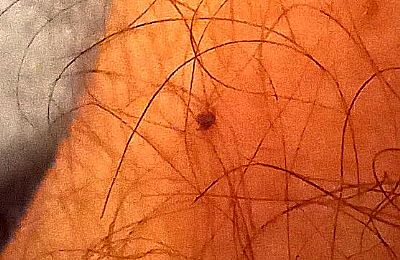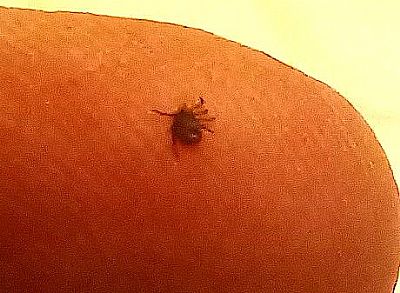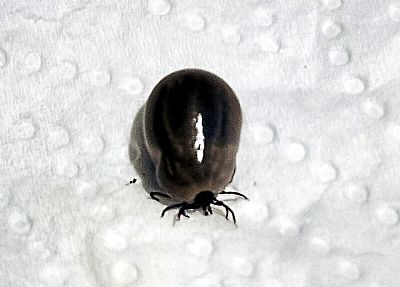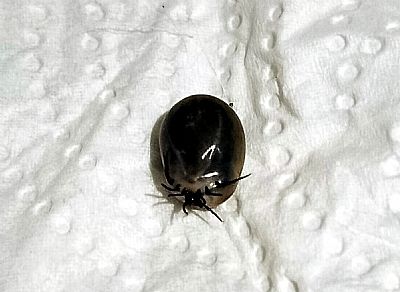TICKS ...... and mites.
When you think of ticks it probably brings to mind small, but plump grey bag-looking "insects". You may be horrified to find one on youself after a walk or brought in by a pet. But they vary quite a bit according to species, gender and life stage.
Ticks seem to add to your concerns, maybe phobias, about being out and about in this great countryside. As if midges were not enough. The wildlife in Scotland can be dangerous. Ticks in Scotland are actually a far greater menace and a major concern for public health.
A tick bites a host animal, including humans, then burrows its head under the skin. While the bite isn’t painful and can go relatively unnoticed by the host organism, the tick can contain harmful bacteria that can cause subsequent maladies. Proper removal of the tick is key in preventing the release of this bacteria. [Healthfully]. While we may imagine them burrowing right in, they only really get their mouth parts in.
Some mites look very similar, but are not a menace to people. See below.
Ixodes ricinus is also known as a deer tick, sheep tick or castor bean tick.
Ixodes hexagonus is also known as the hedgehog tick, as it seems to specialize in feeding from hedgehogs, but it can also be found on foxes, badgers, dogs, and cats. It has a large white bean-shaped body when fully engorged.
It is not possible to fully describe ticks and their effects here, but the links below will take you to useful websites.
These tiny creatures are found globally and are particularly prevalent in areas with warm, humid climates. Their notoriety comes from their capacity as vectors, transmitting a range of diseases to both animals and humans. These diseases, often debilitating and sometimes even life-threatening, are a significant cause for concern.
Along with all the silly signs that we get at gift shops anouncing : "DON'T PANIC" could be one that gives positive advice on how to deal with midges and ticks. While the previous paragraph points out threats, basic precautions and care if one has been bitten can take that away or at least ameiorate it.
Perhaps firstly is being able to recognise them. The males are sometimes little bigger than a full-stop on this page. Dark red and much like a thorn prick. In other words they are absolutely minute. But look closer to see if that dot has embedded itself in your skin... and perhaps has little legs. It can be difficult to see properly with the naked eye. The one in the photo below has already grown substantially. Such tiny ticks have been known to get through clothing, possibly through the fabric itself or climbing up from ankle level. They cannot jump or fly, but use something known as questing to go from a perch such as on a blade of grass to their host be that animal or human.
As they go through their life stages, they change dramatically. The adult engorged female is many times her original size and a shiny grey colour. This is perhaps the most familiar image we have of them.
Awareness is the first protection. We have noticed an increase during the summer of 2025. Anyone walking or gardening or doing other pursuits in grass or scrub may receive scratches and insect bites and simply ignore those very small clots of blood that may occur. But check closely. By squeezing and carefully scratching, you may well discover a tiny tick already biting its way deeper into your skin. Remove it promptly and dispose of it.
Diseases from ticks include the following as described in the Live.Breathe.Scotland website:
Lyme Disease
The most common tick-borne disease in Scotland, Lyme disease, is caused by the bacterium Borrelia burgdorferi. Transmitted through the bite of infected Ixodes ricinus ticks, the symptoms include a red circular rash and flu-like symptoms, and if left untreated, more severe complications such as neurological and joint issues can arise.
Lyme disease can be complicated to treat once it has taken hold, so avoiding ticks and being aware of the early signs of Lyme disease are extremely important.
Anaplasmosis
While less common than Lyme disease, Anaplasmosis is another significant disease transmitted by ticks. This bacterial illness can cause symptoms like fever, headache, muscle aches, and fatigue. Animals, particularly dogs and horses, can also contract anaplasmosis.
Babesiosis
This is a malaria-like illness caused by a parasite that infects red blood cells. Ticks transmit the disease when they bite a host to feed. While rare, it can be a severe disease in people with weakened immune systems, the elderly, and persons without a spleen.
Tick-Borne Encephalitis (TBE)
TBE is a viral infectious disease involving the central nervous system. The disease most often manifests as meningitis, encephalitis, or meningoencephalitis. Long-lasting or permanent neuropsychiatric consequences are observed in 10 to 20% of infected patients. Although it's more common in mainland Europe, a few cases have been reported in the UK, highlighting the need for monitoring.
Prevention and Treatment :
Spray insect repellent: Using an insect repellent that contains DEET can help deter ticks. There are many varieties available and if you are already using something on your arms and neck against midges, add some to your lower legs just in case against ticks.
Protective clothing: Wearing long trousers and long-sleeved tops, preferably wear light-coloured clothing, so ticks are easier to spot, can help prevent tick bites. Most people get ticks on exposed skin on their legs. Guys seem to get more ticks than girls; the little creatures have the added benefit of a ladder of hairs to clamber up or simply to grab as you pass by.
Avoidance of high-risk areas: Sticking to paths and avoiding long grass when walking in areas known for ticks can reduce the chance of encountering them.
Tick Checks and Proper Tick Removal
If you have spent some time in areas known for ticks, you should check themselves, your children and your pet for ticks. The fur of a dog or cat or indeed a horse can hide a small tick for ages before detection, so have a good look. If a tick is found, it should be removed as soon as possible using fine-tipped tweezers or a specially designed tick removal tool. The one in the pictures below was removed using finger nails. It worked well this time, but there is the danger of leaving something of the tick behind. Removal was followed by disinfectant and antihistamines, just in case.

At first it may seem to be simply a very small scab such as when one gets pricked by a thorn, but look closer and you will notice legs. It begins to bite in and becomes at right angles to the skin.

Once removed, its form is all the more obvious. Eight legs. An arachnid. This one made its way into the house in early May, possibly hitching a ride on the family cat.


Two views of the same tick. This is an engorged adult female. When we find them they are most probably attached end on to a pet with the front end biting the host, but they do have a top and a bottom. The lower photos shows it up side down and we can most clearly see the mouth parts and legs. The mouth can break off if pulled off the host so it is best to use suitably sharp tweezers. Fortunately this one came off a cat intact. It is about the size of a pea.
MITES
Many mites look very similar to ticks. Most live on the underside of leaves and can be very detrimental to plants.
Many a family will be aware of those that infect the hair follicles.
Demodex is a type of minuscule mite genus that inhabits the hair follicles of mammals or their vicinity. There are approximately 65 known species of Demodex. Among them, two species reside in humans: Demodex folliculorum and Demodex brevis, commonly known as eyelash mites, face mites, or skin mites interchangeably.
Different species of Demodex are hosted by different animals. For instance, Demodex canis is found in domestic dogs. It's common for various mammalian species to harbor Demodex without causing any noticeable symptoms. ...
Demodex mites are extremely small, measuring between 0.15 to 0.4 millimeters (mm). It would require several of them to cover the head of a pin.
Under a microscope, these mites appear somewhat transparent and are covered with scales. They have an elongated body divided into two segments. The first segment consists of eight legs and a mouth. [DR KASHIF]
HEALTHFULLY : https://healthfully.com/rid-ticks-burrowed-under-skin-5563228.html
LIVE.BREATHE.SCOTLAND website : A comprehensive guide to Ticks in Scotland : https://www.livebreathescotland.com/ticks-in-scotland-guide/#ixodes-ricinus
THE HUMANE SOCIETY : What to do if you find a tick on your doghttps://www.humanesociety.org/resources/what-do-if-you-find-tick-your-dog
LOCH LOMOND & THE TROSSACHS NATIONAL PARK : Useful information: https://www.lochlomond-trossachs.org/looking-after-the-park/be-a-responsible-visitor/ticks-lyme-disease/
PUBLIC HEALTH SCOTLAND : Concerning tick borne disease in humans. https://publichealthscotland.scot/news/2023/april/tick-awareness/
NHS : re Lyme Disease : https://www.nhs.uk/conditions/lyme-disease/

